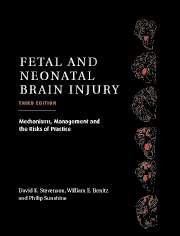Book contents
- Frontmatter
- Contents
- List of contributors
- Foreword
- Preface
- Part I Epidemiology, Pathophysiology, and Pathogenesis of Fetal and Neonatal Brain Injury
- 1 Perinatal asphyxia: an overview
- 2 Mechanisms of brain damage in animal models of hypoxia–ischemia in newborns
- 3 Cellular and molecular biology of perinatal hypoxic–ischemic brain damage
- 4 Fetal responses to asphyxia
- 5 Congenital malformations of the brain
- 6 Prematurity and complications of labor and delivery
- 7 Intrauterine growth retardation (restriction)
- 8 Hemorrhagic lesions of the central nervous system
- Part II Pregnancy, Labor, and Delivery Complications Causing Brain Injury
- Part III Diagnosis of the Infant with Asphyxia
- Part IV Specific Conditions Associated with Fetal and Neonatal Brain Injury
- Part V Management of the Depressed or Neurologically Dysfunctional Neonate
- Part VI Assessing the Outcome of the Asphyxiated Infant
- Index
- Plate section
2 - Mechanisms of brain damage in animal models of hypoxia–ischemia in newborns
from Part I - Epidemiology, Pathophysiology, and Pathogenesis of Fetal and Neonatal Brain Injury
Published online by Cambridge University Press: 10 November 2010
- Frontmatter
- Contents
- List of contributors
- Foreword
- Preface
- Part I Epidemiology, Pathophysiology, and Pathogenesis of Fetal and Neonatal Brain Injury
- 1 Perinatal asphyxia: an overview
- 2 Mechanisms of brain damage in animal models of hypoxia–ischemia in newborns
- 3 Cellular and molecular biology of perinatal hypoxic–ischemic brain damage
- 4 Fetal responses to asphyxia
- 5 Congenital malformations of the brain
- 6 Prematurity and complications of labor and delivery
- 7 Intrauterine growth retardation (restriction)
- 8 Hemorrhagic lesions of the central nervous system
- Part II Pregnancy, Labor, and Delivery Complications Causing Brain Injury
- Part III Diagnosis of the Infant with Asphyxia
- Part IV Specific Conditions Associated with Fetal and Neonatal Brain Injury
- Part V Management of the Depressed or Neurologically Dysfunctional Neonate
- Part VI Assessing the Outcome of the Asphyxiated Infant
- Index
- Plate section
Summary
Perinatal hypoxia–ischemia (HI) in newborns is a major cause of pediatric mortality and morbidity and causes brain damage resulting in lifelong neurobehavioral handicaps. Systemic asphyxia resulting from a disruption in placental gas exchange occurs perinatally in 2–4 per 1000 full-term infants. Approximately 15–20% of infants who develop brain damage subsequently die during the newborn period, and up to 25% of survivors exhibit permanent neurological disabilities. Neurologic abnormalities, such as movement disorders (e.g., ataxia, choreoathetosis, diplegia, or dystonia), epilepsy, and developmental delay, are possible lifelong consequences that occur following perinatal HI. Preterm or term HI infants have damage in the forebrain and brain stem, with basal ganglia and somatosensory systems showing selective vulnerability. The mechanisms for this brain damage and the resulting neurologic disorders in newborns are still not understood. Unfortunately, no treatments for the prevention or amelioration of this neurologic injury are available for infants and children who have suffered HI.
Animal models are essential for understanding the mechanisms of hypoxic-ischemic encephalopathy (HIE). These models are important because it is very difficult to study directly the process of nerve cell death by analyzing individuals with HIE. The advanced brain-imaging technologies have insufficient resolution to study directly dying neurons at cellular and molecular levels in living patients. When patients with HIE die and when postmortem brain samples become available for experimentation, neurological and neuropathological associations can be gleaned, but cause-and-effect relationships are difficult to identify.
- Type
- Chapter
- Information
- Fetal and Neonatal Brain InjuryMechanisms, Management and the Risks of Practice, pp. 30 - 57Publisher: Cambridge University PressPrint publication year: 2003
- 4
- Cited by

